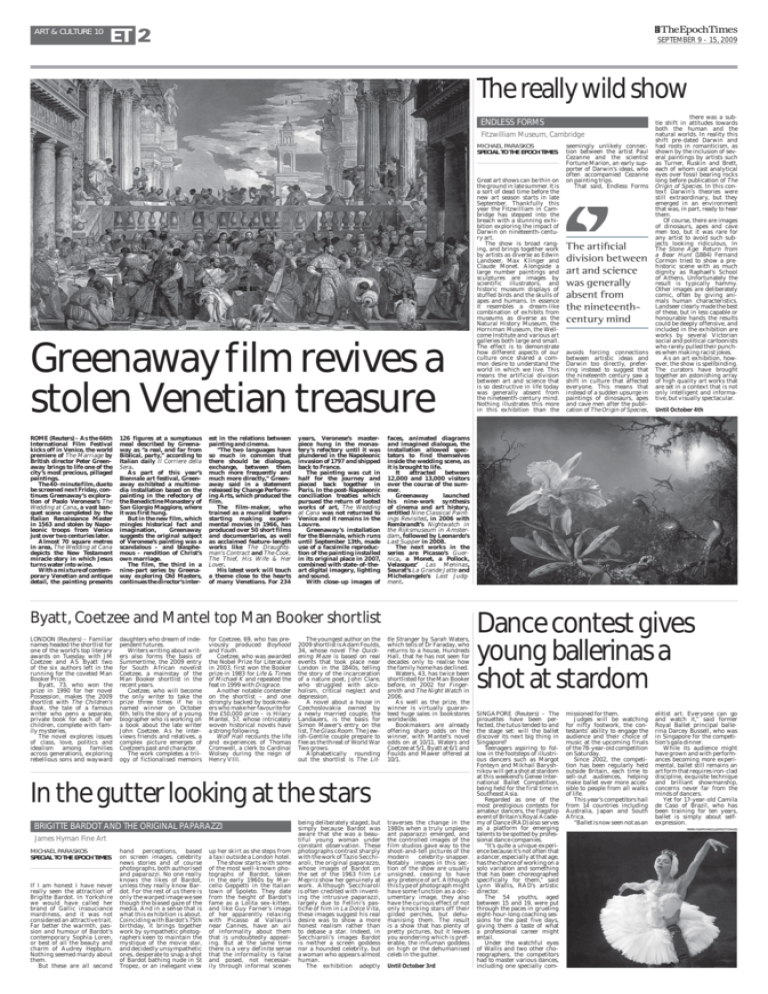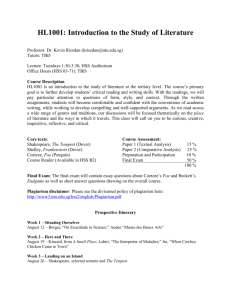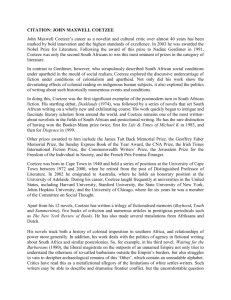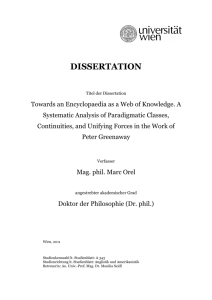Greenaway film revives a stolen Venetian treasure
advertisement

ART & CULTURE 10 SEPTEMBER 9 - 15, 2009 The really wild show ENDLESS FORMS Fitzwilliam Museum, Cambridge MICHAEL PARASKOS SPECIAL TO THE EPOCH TIMES Greenaway film revives a stolen Venetian treasure ROME (Reuters) - As the 66th International Film Festival kicks off in Venice, the world premiere of The Marriage by British director Peter Greenaway brings to life one of the city’s most precious, pillaged paintings. The 40-minute film, due to be screened next Friday, continues Greenaway’s exploration of Paolo Veronese’s The Wedding at Cana, a vast banquet scene completed by the Italian Renaissance Master in 1563 and stolen by Napoleonic troops from Venice just over two centuries later. Almost 70 square metres in area, The Wedding at Cana depicts the New Testament miracle story in which Jesus turns water into wine. With a mixture of contemporary Venetian and antique detail, the painting presents 126 figures at a sumptuous meal described by Greenaway as “a real, and far from Biblical, party,” according to Italian daily Il Corriere della Sera. As part of this year’s Biennale art festival, Greenaway exhibited a multimedia installation based on the painting in the refectory of the Benedictine Monastery of San Giorgio Maggiore, where it was first hung. But in the new film, which mingles historical fact and imagination, Greenaway suggests the original subject of Veronese’s painting was a scandalous – and blasphemous – rendition of Christ’s own marriage. The film, the third in a nine-part series by Greenaway exploring Old Masters, continues the director’s inter- est in the relations between painting and cinema. “The two languages have so much in common that there should be dialogue, exchange, between them much more frequently and much more directly,” Greenaway said in a statement released by Change Performing Arts, which produced the film. The film-maker, who trained as a muralist before starting making experimental movies in 1966, has produced over 50 short films and documentaries, as well as acclaimed feature-length works like The Draughtsman’s Contract and The Cook, The Thief, His Wife & Her Lover. His latest work will touch a theme close to the hearts of many Venetians. For 234 years, Veronese’s masterpiece hung in the monastery’s refectory until it was plundered in the Napoleonic invasion of 1797 and shipped back to France. The painting was cut in half for the journey and pieced back together in Paris. In the post-Napoleonic conciliation treaties which pursued the return of looted works of art, The Wedding at Cana was not returned to Venice and it remains in the Louvre. Greenaway’s installation for the Biennale, which runs until September 13th, made use of a facsimile reproduction of the painting installed in its original place in 2007, combined with state-of-theart digital imagery, lighting and sound. With close-up images of daughters who dream of independent futures. Writers writing about writers also forms the basis of Summertime, the 2009 entry for South African novelist Coetzee, a mainstay of the Man Booker shortlist in the recent years. Coetzee, who will become the only writer to take the prize three times if he is named winner on October 6th, tells the story of a young biographer who is working on a book about the late writer John Coetzee. As he interviews friends and relatives, a complex picture emerges of Coetzee’s past and character. The work completes a trilogy of fictionalised memoirs for Coetzee, 69, who has previously produced Boyhood and Youth. Coetzee, who was awarded the Nobel Prize for Literature in 2003, first won the Booker prize in 1983 for Life & Times of Michael K and repeated the feat in 1999 with Disgrace. Another notable contender on the shortlist – and one strongly backed by bookmakers who make her favourite for the £50,000 prize – is Hilary Mantel, 57, whose intricately woven historical novels have a strong following. Wolf Hall recounts the life and experiences of Thomas Cromwell, a clerk to Cardinal Wolsey during the reign of Henry VIII. The youngest author on the 2009 shortlist is Adam Foulds, 34, whose novel The Quickening Maze is based on real events that took place near London in the 1840s, telling the story of the incarceration of a nature poet, John Clare, who struggled with alcoholism, critical neglect and depression. A novel about a house in Czechoslovakia owned by a newly married couple, the Landauers, is the basis for Simon Mawer’s entry on the list, The Glass Room. The Jewish-Gentile couple prepare to flee as the threat of World War Two grows. Alphabetically rounding out the shortlist is The Lit- tle Stranger by Sarah Waters, which tells of Dr Faraday, who returns to a house, Hundreds Hall, that he has not seen for decades only to realise how the family home has declined. Waters, 43, has twice been shortlisted for the Man Booker before, in 2002 for Fingersmith and The Night Watch in 2006. As well as the prize, the winner is virtually guaranteed huge sales in bookstores worldwide. Bookmakers are already offering sharp odds on the winner, with Mantel’s novel odds on at 10/11, Waters and Coetzee at 5/1, Byatt at 6/1 and Foulds and Mawer offered at 10/1. In the gutter looking at the stars BRIGITTE BARDOT AND THE ORIGINAL PAPARAZZI James Hyman Fine Art MICHAEL PARASKOS SPECIAL TO THE EPOCH TIMES If I am honest I have never really seen the attraction of Brigitte Bardot. In Yorkshire we would have called her brand of Gallic insouciance mardiness, and it was not considered an attractive trait. Far better the warmth, passion and humour of Bardot’s contemporary Sophia Loren, or best of all the beauty and charm of Audrey Hepburn. Nothing seemed mardy about them. But these are all second hand perceptions, based on screen images, celebrity news stories and of course photographs, both authorised and paparazzi. No one really knows the likes of Bardot, unless they really know Bardot. For the rest of us there is only the warped image we see though the biased gaze of the media. And in a sense that is what this exhibition is about. Coinciding with Bardot’s 75th birthday, it brings together work by sympathetic photographers keen to maintain the mystique of the movie star, and decidedly unsympathetic ones, desperate to snap a shot of Bardot bathing nude in St Tropez, or an inelegant view up her skirt as she steps from a taxi outside a London hotel. The show starts with some of the most well-known photographs of Bardot, taken in the early 1960s by Marcello Geppetti in the Italian town of Spoleto. They date from the height of Bardot’s fame as a Lolita sex-kitten, and like Guy Farner’s image of her apparently relaxing with Picasso at Vallauris near Cannes, have an air of informality about them that is undoubtedly appealing. But at the same time there is a very definite sense that the informality is false and posed, not necessarily through informal scenes being deliberately staged, but simply because Bardot was aware that she was a beautiful young woman under constant observation. These photographs contrast sharply with the work of Tazio Secchiaroli, the original paparazzo, whose images of Bardot on the set of the 1963 film Le Mepris show her genuinely at work. Although Secchiaroli is often credited with inventing the intrusive paparazzi, largely due to Fellini’s pastiche of him in La Dolce Vita, these images suggest his real desire was to show a more honest realism rather than to debase a star. Indeed, in Secchiaroli’s images Bardot is neither a screen goddess nor a hounded celebrity, but a woman who appears almost human. The exhibition adeptly The artificial division between art and science was generally absent from the nineteenthcentury mind avoids forcing connections between artistic ideas and Darwin too directly, preferring instead to suggest that the nineteenth century saw a shift in culture that affected everyone. This means that instead of a sudden upsurge in paintings of dinosaurs, apes and cave men after the publication of The Origin of Species, Until October 4th faces, animated diagrams and imagined dialogue, the installation allowed spectators to find themselves inside the wedding scene, as it is brought to life. It attracted between 12,000 and 13,000 visitors over the course of the summer. Greenaway launched his nine-work synthesis of cinema and art history, entitled Nine Classical Paintings Revisited, in 2006 with Rembrandt’s Nightwatch in the Rijksmuseum in Amsterdam, followed by Leonardo’s Last Supper in 2008. The next works in the series are Picasso’s Guernica, a Monet, a Pollock, Velasquez’ Las Meninas, Seurat’s La Grande Jatte and Michelangelo’s Last Judgment. Byatt, Coetzee and Mantel top Man Booker shortlist LONDON (Reuters) – Familiar names headed the shortlist for one of the world’s top literary awards on Tuesday with JM Coetzee and AS Byatt two of the six authors left in the running for the coveted Man Booker Prize. Byatt, 73, who won the prize in 1990 for her novel Possession, makes the 2009 shortlist with The Children’s Book, the tale of a famous writer who pens a separate, private book for each of her children, complete with family mysteries. The novel explores issues of class, love, politics and idealism among families across generations, exploring rebellious sons and wayward Great art shows can be thin on the ground in late summer. It is a sort of dead time before the new art season starts in late September. Thankfully this year the Fitzwilliam in Cambridge has stepped into the breach with a stunning exhibition exploring the impact of Darwin on nineteenth-century art. The show is broad ranging, and brings together work by artists as diverse as Edwin Landseer, Max Klinger and Claude Monet. Alongside a large number paintings and sculptures are images by scientific illustrators, and historic museum displays of stuffed birds and the skulls of apes and humans. In essence it resembles a dream-like combination of exhibits from museums as diverse as the Natural History Museum, the Horniman Museum, the Wellcome Institute and various art galleries both large and small. The effect is to demonstrate how different aspects of our culture once shared a common desire to understand the world in which we live. This means the artificial division between art and science that is so destructive in life today was generally absent from the nineteenth-century mind. Nothing illustrates this more in this exhibition than the seemingly unlikely connection between the artist Paul Cezanne and the scientist Fortune Marion, an early supporter of Darwin’s ideas, who often accompanied Cezanne on painting trips. That said, Endless Forms there was a subtle shift in attitudes towards both the human and the natural worlds. In reality this shift pre-dated Darwin and had roots in romanticism, as shown by the inclusion of several paintings by artists such as Turner, Ruskin and Brett, each of whom cast analytical eyes over fossil bearing rocks long before publication of The Origin of Species. In this context Darwin’s theories were still extraordinary, but they emerged in an environment that was, in part, ready to hear them. Of course, there are images of dinosaurs, apes and cave men too, but it was rare for any artist to avoid such subjects looking ridiculous. In The Stone Age: Return from a Bear Hunt (1884) Fernand Cormon tried to show a prehistoric scene with as much dignity as Raphael’s School of Athens. Unfortunately the result is typically hammy. Other images are deliberately comic, often by giving animals human characteristics. Landseer clearly made the best of these, but in less capable or honourable hands the results could be deeply offensive, and included in the exhibition are works by several Victorian social and political cartoonists who rarely pulled their punches when making racist jokes. As an art exhibition, however, the show is spellbinding. The curators have brought together an astonishing array of high quality art works that are set in a context that is not only intelligent and informative, but visually spectacular. traverses the change in the 1980s when a truly unpleasant paparazzi emerged, and the controlled images of the film studios gave way to the shoot-and-tell pictures of the modern celebrity-snapper. Notably images in this section of the show are usually unsigned, ceasing to have any pretence of art. Although this type of photograph might have some function as a documentary image, they also have the curious effect of not only knocking stars off their gilded perches, but dehumanising them. The result is a show that has plenty of pretty pictures, but it leaves you wondering which is preferable, the inhuman goddess on high or the dehumanised celeb in the gutter. Until October 3rd Dance contest gives young ballerinas a shot at stardom SINGAPORE (Reuters) – The pirouettes have been perfected, the tutus tended to and the stage set: will the ballet discover its next big thing in Singapore? Teenagers aspiring to follow in the footsteps of illustrious dancers such as Margot Fonteyn and Mikhail Baryshnikov will get a shot at stardom at this weekend’s Genee International Ballet Competition, being held for the first time in Southeast Asia. Regarded as one of the most prestigious contests for amateur dancers, the flagship event of Britain’s Royal Academy of Dance (RAD) also serves as a platform for emerging talents to be spotted by professional dance companies. “It’s quite a unique experience because it’s not often that a dancer, especially at that age, has the chance of working on a solo variation and something that has been choreographed specifically for them,” said Lynn Wallis, RAD’s artistic director. The 54 youths, aged between 15 and 19, were put through the paces in grueling eight-hour-long coaching sessions for the past five days, giving them a taste of what a professional career might entail. Under the watchful eyes of Wallis and two other choreographers, the competitors had to master various dances, including one specially com- missioned for them. Judges will be watching for nifty footwork, the contestants’ ability to engage the audience and their choice of music at the upcoming finals of the 78-year-old competition on Saturday. Since 2002, the competition has been regularly held outside Britain, each time to sell-out audiences, helping make ballet ever more accessible to people from all walks of life. This year’s competitors hail from 14 countries including Australia, Japan and South Africa. “Ballet is now seen not as an elitist art. Everyone can go and watch it,” said former Royal Ballet principal ballerina Darcey Bussell, who was in Singapore for the competition’s gala dinner. While its audience might have grown and with performances becoming more experimental, ballet still remains an art form that requires iron-clad discipline, exquisite technique and brilliant showmanship, concerns never far from the minds of dancers. Yet for 17-year-old Camila de Caso of Brazil, who has been training for ten years, ballet is simply about selfexpression. PIERRE-PHILIPPE MARCOU/AFP/GETTY IMAGES









